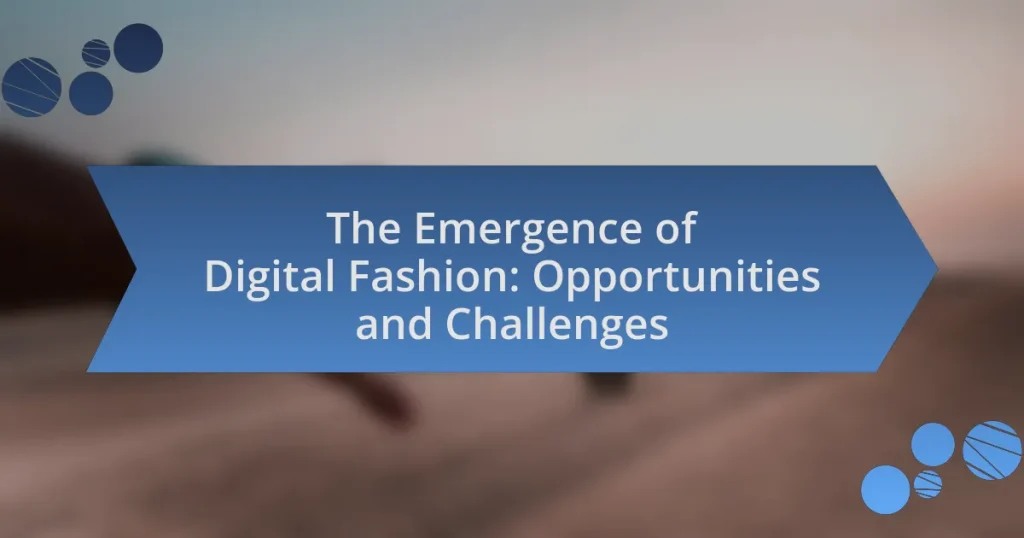Digital fashion is defined as clothing and accessories created for virtual environments using technologies like 3D modeling and augmented reality. The article explores the evolution of digital fashion from its early gaming roots to its current applications in marketing and sustainability, highlighting the role of technological advancements and cultural shifts. Key characteristics include its virtual nature, interactivity, and potential for reducing environmental impact. The article also addresses the economic opportunities, challenges, and ethical considerations associated with digital fashion, emphasizing the importance of inclusivity and responsible practices for brands in this emerging sector.

What is Digital Fashion?
Digital fashion refers to clothing and accessories created and experienced in virtual environments, often utilizing 3D modeling and augmented reality technologies. This innovative approach allows designers to create garments that exist solely in digital form, enabling virtual try-ons and immersive fashion experiences. The rise of digital fashion is supported by the increasing popularity of virtual worlds and online platforms, with brands like Balenciaga and Gucci launching digital collections, highlighting its growing significance in the fashion industry.
How has Digital Fashion evolved over time?
Digital fashion has evolved significantly from its inception in the early 2000s, transitioning from simple digital garments in video games to complex virtual clothing designed for social media and online avatars. Initially, digital fashion was primarily used in gaming environments, where designers created outfits for characters, but as technology advanced, the rise of augmented reality (AR) and virtual reality (VR) expanded its applications. By the 2010s, brands began to explore digital fashion for marketing and engagement, leading to collaborations with influencers and the introduction of virtual fashion shows. The COVID-19 pandemic accelerated this trend, as physical events were replaced by digital experiences, highlighting the potential for digital-only collections. According to a report by McKinsey & Company, the global fashion industry is projected to reach $3 trillion by 2030, with digital fashion playing a crucial role in this growth, particularly in the realms of sustainability and consumer engagement.
What technological advancements have influenced Digital Fashion?
Technological advancements such as 3D modeling, virtual reality (VR), augmented reality (AR), and blockchain have significantly influenced digital fashion. 3D modeling allows designers to create realistic garments digitally, enabling rapid prototyping and reducing material waste. Virtual reality and augmented reality enhance consumer experiences by allowing users to try on clothes virtually, bridging the gap between physical and digital shopping. Blockchain technology provides transparency and authenticity in digital fashion, ensuring ownership and provenance of digital assets. These advancements collectively reshape the fashion industry by promoting sustainability, enhancing consumer engagement, and enabling new business models.
How do cultural shifts impact the emergence of Digital Fashion?
Cultural shifts significantly influence the emergence of Digital Fashion by altering consumer behaviors, values, and technological adoption. As society increasingly embraces digital experiences, the demand for virtual clothing and avatars rises, reflecting a broader acceptance of online identities. For instance, the rise of social media platforms has led to a culture where self-expression through digital means is prioritized, driving brands to create digital garments for virtual environments. Additionally, the growing emphasis on sustainability has prompted fashion brands to explore digital alternatives, reducing waste associated with traditional fashion production. This shift is evidenced by the increasing number of collaborations between fashion designers and tech companies, such as the partnership between Balenciaga and Fortnite, which showcases how cultural trends can create new avenues for digital fashion innovation.
What are the key characteristics of Digital Fashion?
Digital fashion is characterized by its virtual nature, interactivity, and sustainability. Unlike traditional fashion, digital fashion exists solely in digital environments, allowing for limitless creativity and innovation without the constraints of physical materials. This form of fashion enables users to engage with clothing through augmented reality and virtual reality platforms, enhancing the consumer experience. Additionally, digital fashion promotes sustainability by reducing waste associated with physical production, as it eliminates the need for raw materials and minimizes carbon footprints. The rise of non-fungible tokens (NFTs) in digital fashion also allows for unique ownership and provenance of digital garments, further distinguishing it from conventional fashion.
How does Digital Fashion differ from traditional fashion?
Digital fashion differs from traditional fashion primarily in its medium and application, as digital fashion exists in virtual environments while traditional fashion is tangible and worn in the physical world. Digital fashion allows for the creation of clothing that can be worn in digital spaces, such as video games and virtual reality, enabling designers to experiment without the constraints of physical materials and production costs. For instance, brands like Balenciaga and Gucci have launched digital-only collections, showcasing the potential for limitless creativity and sustainability in fashion. This shift also reflects a growing consumer interest in virtual identities and online presence, as evidenced by the rise of platforms like DressX, which specializes in digital clothing.
What role does sustainability play in Digital Fashion?
Sustainability plays a crucial role in digital fashion by significantly reducing the environmental impact associated with traditional fashion production. Digital fashion eliminates the need for physical materials, thereby decreasing waste, water usage, and carbon emissions linked to manufacturing processes. For instance, a report by McKinsey & Company highlights that the fashion industry is responsible for 10% of global carbon emissions, and transitioning to digital alternatives can mitigate this impact. Additionally, digital fashion allows for virtual try-ons and digital garments, which further minimizes the need for overproduction and unsold inventory, addressing the issue of textile waste.

What opportunities does Digital Fashion present?
Digital fashion presents opportunities for innovation in design, sustainability, and consumer engagement. The integration of technology allows designers to create virtual garments that reduce waste and resource consumption, addressing environmental concerns in the fashion industry. For instance, digital fashion can enable brands to produce limited runs of clothing, minimizing overproduction and excess inventory. Additionally, platforms like virtual reality and augmented reality enhance consumer experiences by allowing customers to try on clothes digitally, leading to increased engagement and personalized shopping experiences. This shift not only opens new revenue streams for brands but also fosters a more sustainable approach to fashion consumption.
How can brands leverage Digital Fashion for marketing?
Brands can leverage Digital Fashion for marketing by creating virtual clothing and accessories that consumers can use in digital environments, such as social media and gaming platforms. This approach allows brands to engage with younger, tech-savvy audiences who are increasingly interested in virtual experiences. For instance, in 2021, Balenciaga collaborated with the video game Fortnite to launch a digital collection, which not only increased brand visibility but also generated significant sales in both digital and physical products. By utilizing augmented reality (AR) and virtual reality (VR) technologies, brands can enhance customer experiences, allowing consumers to try on digital garments before purchase, thereby driving engagement and sales.
What are the benefits of virtual fashion shows?
Virtual fashion shows offer several benefits, including increased accessibility, cost-effectiveness, and enhanced audience engagement. These shows allow brands to reach a global audience without the limitations of physical venues, enabling viewers from diverse locations to participate. According to a report by McKinsey & Company, the digital fashion market is projected to grow significantly, highlighting the shift towards online platforms. Additionally, virtual shows reduce costs associated with traditional events, such as venue rental and logistics, while providing innovative ways to showcase collections through interactive technology. This format also fosters greater audience interaction, as viewers can engage with content in real-time, enhancing their overall experience.
How does Digital Fashion enhance consumer engagement?
Digital fashion enhances consumer engagement by providing immersive and interactive experiences that allow consumers to personalize their fashion choices. This engagement is facilitated through virtual try-ons, augmented reality applications, and social media integration, which enable consumers to visualize how digital garments would look on them in real-time. For instance, a study by McKinsey & Company highlights that brands utilizing augmented reality saw a 94% higher conversion rate compared to those that did not. This statistic underscores the effectiveness of digital fashion in capturing consumer interest and driving purchasing decisions.
What economic opportunities arise from Digital Fashion?
Digital fashion creates economic opportunities through the development of virtual clothing, digital marketplaces, and innovative marketing strategies. The rise of virtual fashion allows brands to sell digital garments for avatars in online environments, tapping into the growing gaming and social media markets, which are projected to reach $200 billion by 2023. Additionally, digital fashion reduces production costs and environmental impact, as it eliminates the need for physical materials and logistics. This shift enables brands to experiment with designs and reach global audiences without traditional barriers, fostering new revenue streams and enhancing consumer engagement.
How can Digital Fashion create new revenue streams?
Digital fashion can create new revenue streams through virtual clothing sales, digital wearables, and collaborations with gaming platforms. By selling virtual garments for avatars in online environments, brands tap into the growing market of digital goods, which is projected to reach $190 billion by 2025. Additionally, partnerships with gaming companies allow fashion brands to integrate their designs into popular games, enhancing brand visibility and engagement. This strategy not only diversifies income sources but also attracts a younger, tech-savvy audience, further solidifying the financial potential of digital fashion.
What impact does Digital Fashion have on job creation in the industry?
Digital fashion significantly impacts job creation in the industry by generating new roles in design, marketing, and technology. The rise of virtual clothing and digital fashion shows has led to an increased demand for digital designers, 3D modelers, and virtual reality specialists. According to a report by McKinsey & Company, the digital fashion market is projected to grow, creating opportunities for approximately 1.5 million jobs globally by 2030. This growth is driven by the integration of technology in fashion, which requires skilled professionals to innovate and manage digital assets.

What challenges does Digital Fashion face?
Digital fashion faces several challenges, including technological limitations, market acceptance, and sustainability concerns. Technological limitations hinder the creation of high-quality digital garments that can seamlessly integrate into various platforms. Market acceptance is a significant barrier, as consumers and brands may be hesitant to adopt digital fashion due to a lack of understanding or perceived value. Additionally, sustainability concerns arise from the energy consumption associated with digital fashion production and the environmental impact of virtual platforms. These challenges must be addressed for digital fashion to thrive in the evolving fashion landscape.
What are the technological barriers to widespread adoption of Digital Fashion?
The technological barriers to widespread adoption of Digital Fashion include limited interoperability between platforms, high computational requirements for rendering, and insufficient consumer hardware capabilities. Interoperability issues arise because various digital fashion platforms often use different file formats and standards, making it difficult for users to seamlessly transfer and utilize digital garments across multiple environments. High computational requirements for rendering realistic digital clothing can deter users with less powerful devices, as advanced graphics processing is necessary for an optimal experience. Additionally, many consumers lack the necessary hardware, such as augmented reality devices or high-performance computers, to fully engage with digital fashion experiences. These barriers collectively hinder the broader acceptance and integration of digital fashion into everyday life.
How do issues of digital ownership and copyright affect Digital Fashion?
Issues of digital ownership and copyright significantly impact Digital Fashion by determining who has the rights to create, distribute, and profit from digital garments. The rise of digital fashion has led to complex legal challenges, as traditional copyright laws often struggle to address the unique characteristics of digital assets, such as ease of replication and distribution. For instance, unauthorized use of digital designs can lead to disputes over intellectual property rights, affecting designers’ ability to monetize their creations. Furthermore, the lack of clear regulations can hinder innovation, as creators may be reluctant to share their work or collaborate due to fears of infringement. This situation underscores the need for updated legal frameworks that can adequately protect digital fashion creators while fostering a thriving digital marketplace.
What challenges exist in ensuring quality and authenticity in Digital Fashion?
Ensuring quality and authenticity in digital fashion faces significant challenges, primarily due to the lack of standardized practices and the ease of digital replication. The absence of industry-wide guidelines leads to inconsistencies in quality, as different creators may use varying software and techniques, resulting in products that do not meet consumer expectations. Furthermore, the digital nature of fashion allows for easy copying and modification, making it difficult to verify the originality of designs. This issue is compounded by the rise of counterfeit digital goods, which can undermine brand integrity and consumer trust. According to a report by the International Trademark Association, the global economic impact of counterfeiting is estimated to reach $4.2 trillion by 2022, highlighting the urgency of addressing authenticity in digital fashion.
How does consumer perception impact the future of Digital Fashion?
Consumer perception significantly shapes the future of digital fashion by influencing purchasing decisions and brand loyalty. As consumers increasingly view digital fashion as a legitimate and desirable alternative to traditional clothing, their acceptance drives innovation and investment in this sector. For instance, a survey by McKinsey & Company in 2021 indicated that 60% of consumers are open to purchasing digital clothing for virtual environments, highlighting a shift in perception that legitimizes digital fashion. This growing acceptance encourages brands to explore new digital offerings, ultimately shaping market trends and consumer experiences in the fashion industry.
What are the common misconceptions about Digital Fashion?
Common misconceptions about digital fashion include the belief that it lacks authenticity, is only for gaming or virtual environments, and is not sustainable. Many people think digital fashion is merely a gimmick, failing to recognize that it can represent real-world brands and designers, as evidenced by collaborations between established fashion houses and digital platforms. Additionally, digital fashion is often associated solely with gaming, overlooking its applications in social media, virtual reality, and online retail. Furthermore, the assumption that digital fashion contributes to environmental harm is misleading; in fact, it can reduce waste by minimizing physical production and promoting virtual try-ons, which can lead to more sustainable consumer behavior.
How can brands address consumer skepticism towards Digital Fashion?
Brands can address consumer skepticism towards Digital Fashion by enhancing transparency and demonstrating the value of digital garments. By providing clear information about the technology behind digital fashion, including how items are created and their environmental impact, brands can build trust. For instance, a study by McKinsey & Company highlights that 66% of consumers are willing to pay more for sustainable products, indicating that emphasizing sustainability in digital fashion can alleviate skepticism. Additionally, brands can engage consumers through interactive experiences, such as virtual try-ons or augmented reality applications, which can help consumers visualize and understand the benefits of digital fashion.
What are the ethical considerations in Digital Fashion?
Ethical considerations in digital fashion include sustainability, intellectual property rights, and inclusivity. Sustainability is crucial as digital fashion can reduce waste associated with traditional clothing production, but it also raises concerns about the environmental impact of digital assets and energy consumption in blockchain technologies. Intellectual property rights are significant because digital designs can be easily copied and distributed, leading to potential infringement issues. Inclusivity is essential as digital fashion should cater to diverse body types and cultural representations, ensuring that virtual clothing is accessible and representative of all consumers. These considerations highlight the need for responsible practices in the evolving landscape of digital fashion.
How does Digital Fashion address issues of inclusivity and diversity?
Digital fashion addresses issues of inclusivity and diversity by enabling the creation of virtual garments that cater to a wide range of body types, ethnicities, and gender identities. This technology allows designers to produce clothing that is not limited by physical constraints, thus promoting representation across various demographics. For instance, brands like The Fabricant and DressX have developed digital clothing lines that feature diverse avatars, showcasing styles for different cultural backgrounds and body shapes. Additionally, digital fashion eliminates the need for traditional sizing, allowing consumers to personalize their virtual outfits, which further enhances inclusivity. This approach is supported by the growing trend of virtual fashion shows and online platforms that prioritize diverse representation, demonstrating a commitment to inclusivity in the fashion industry.
What responsibilities do brands have in promoting ethical practices in Digital Fashion?
Brands have a responsibility to ensure ethical practices in Digital Fashion by prioritizing sustainability, transparency, and inclusivity. This includes using eco-friendly materials, minimizing digital waste, and ensuring fair labor practices in the creation of digital assets. For instance, a report by McKinsey & Company highlights that the fashion industry is responsible for 10% of global carbon emissions, emphasizing the need for brands to adopt sustainable practices. Additionally, brands should disclose their supply chain processes and engage in fair trade to build consumer trust and accountability. By adhering to these principles, brands can contribute to a more ethical and responsible digital fashion landscape.
What practical steps can brands take to succeed in Digital Fashion?
Brands can succeed in Digital Fashion by embracing innovative technologies, engaging with their audience through immersive experiences, and collaborating with digital artists. Implementing augmented reality (AR) and virtual reality (VR) can enhance customer interaction, as evidenced by brands like Gucci and Balenciaga, which have successfully integrated these technologies into their marketing strategies. Additionally, fostering community engagement through social media platforms and virtual events allows brands to build a loyal customer base, as seen with the rise of digital fashion shows and influencer partnerships. Collaborating with digital artists not only diversifies product offerings but also taps into the growing market for NFTs, which has seen significant sales, such as the $69 million sale of a digital artwork by Beeple. These steps collectively position brands to thrive in the evolving landscape of Digital Fashion.















